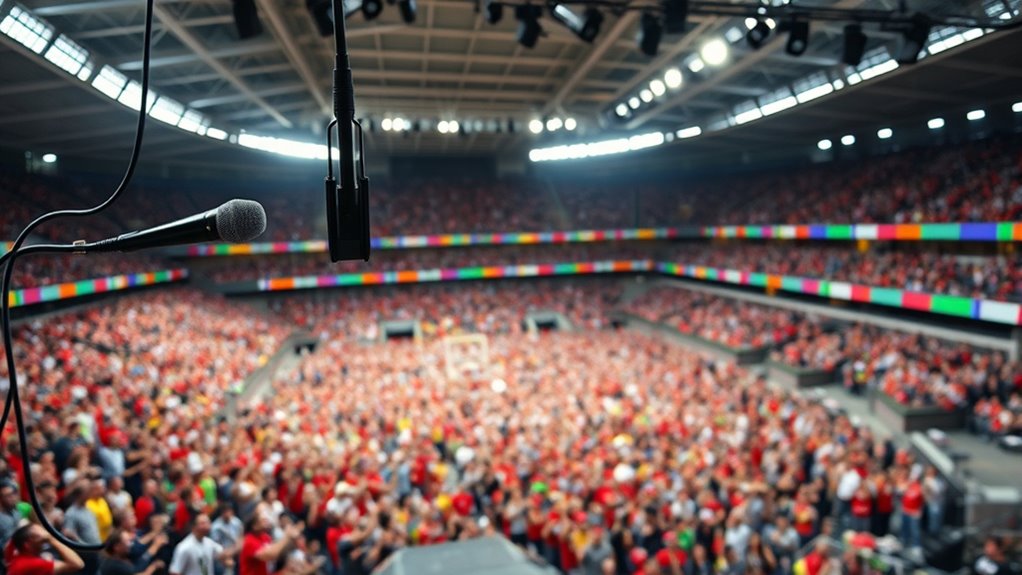To engineer stadium sound for chants, you position directional microphones close to crowd sources and use powerful, well-placed speakers to amplify devout cheers. You calibrate audio levels carefully, minimize echo with acoustic design, and synchronize sound with visuals for a seamless experience. Utilizing digital processors and real-time monitoring helps manage reverberations and maintain clarity. If you keep exploring, you’ll discover how advanced systems improve chant power and overall atmosphere even further.
Key Takeaways
- Position directional microphones near chant sources to capture clear, focused crowd sounds while minimizing background noise.
- Use synchronized delay systems and speaker placement to ensure chants are evenly projected across all stadium sections.
- Calibrate sound levels during pre-event setup and monitor microphones continuously for real-time adjustments.
- Apply reverberation control and acoustic treatments to reduce echo and enhance chant clarity throughout the stadium.
- Utilize advanced audio zoning and intelligent speakers to adapt sound delivery based on crowd density and ambient noise.
The Role of Sound Engineers at Sports Venues
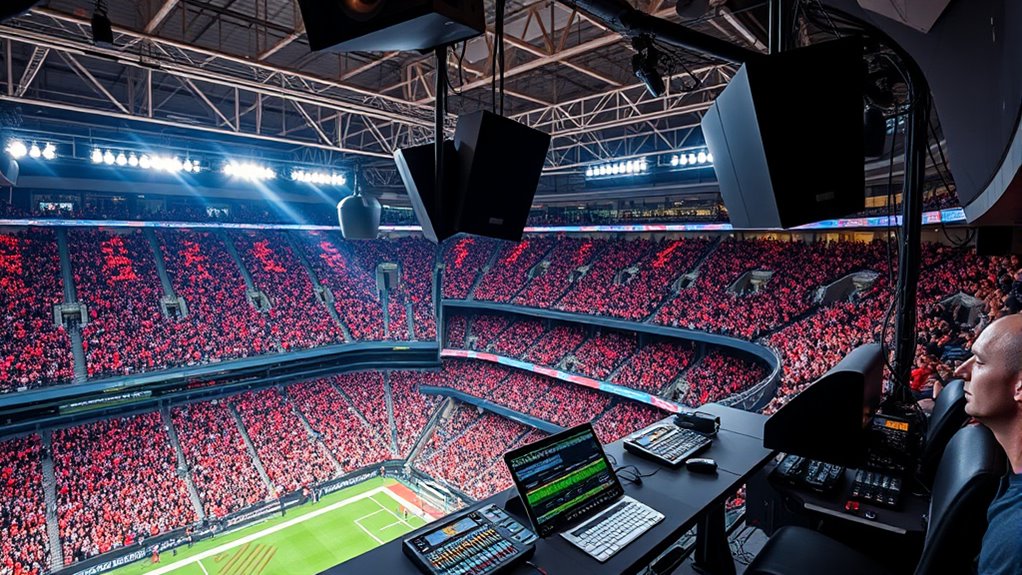
Sound engineers play an essential role at sports venues by ensuring that every announcement, cheer, and piece of music reaches the audience clearly and at the right volume. You must constantly analyze crowd acoustics, understanding how the audience’s size and movement affect sound quality. Proper seating arrangements are also fundamental, as they influence how sound travels throughout the stadium. By strategically positioning speakers and adjusting sound levels based on seating layouts, you can minimize dead spots and echo. Your goal is to create a balanced audio environment where every fan hears the same clear, loud sound, no matter where they sit. This requires real-time adjustments and a keen awareness of how crowd dynamics impact acoustics during the game. Utilizing sound system calibration techniques helps optimize audio clarity and consistency across the venue.
Essential Equipment for Stadium Sound Management
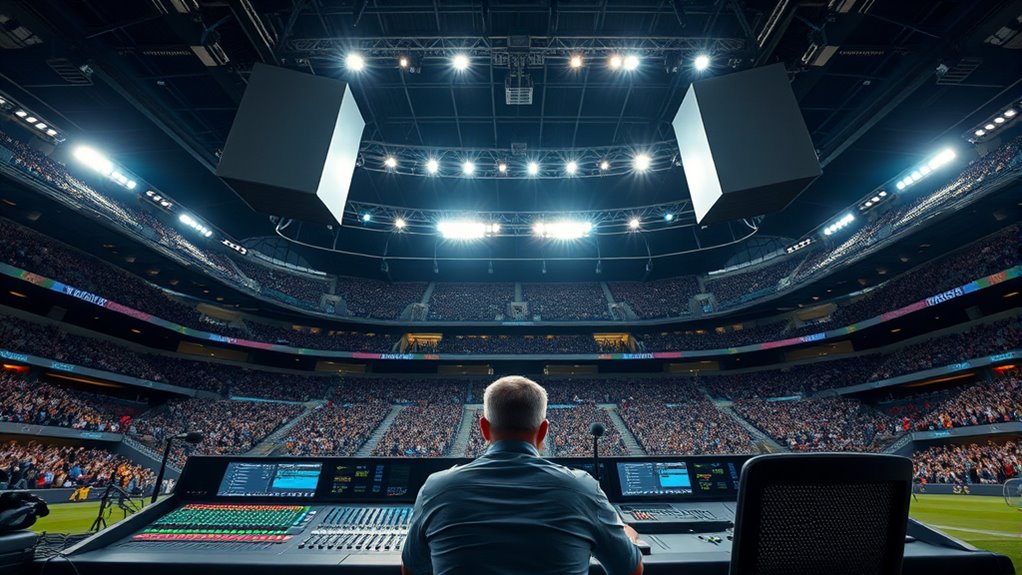
To effectively manage audio in a stadium, you need a suite of reliable and high-quality equipment. First, invest in powerful PA systems with strategically placed speakers to ensure sound reaches all stadium seating areas clearly. Second, use wireless microphones and microphones with noise reduction features to capture chants and crowd sounds without interference. Third, incorporate audio mixers that allow you to control levels quickly, especially during high-energy moments. Additionally, integrating ticketing technology helps coordinate crowd flow and manage sound zones, ensuring announcements and music are synchronized with seating arrangements. Proper equipment guarantees that sound quality remains consistent, and the atmosphere stays energized, making every chant loud and clear for fans everywhere in the stadium. Implementing real-time monitoring systems can further optimize sound performance by providing immediate feedback and adjustments.
Techniques for Balancing Microphone Levels
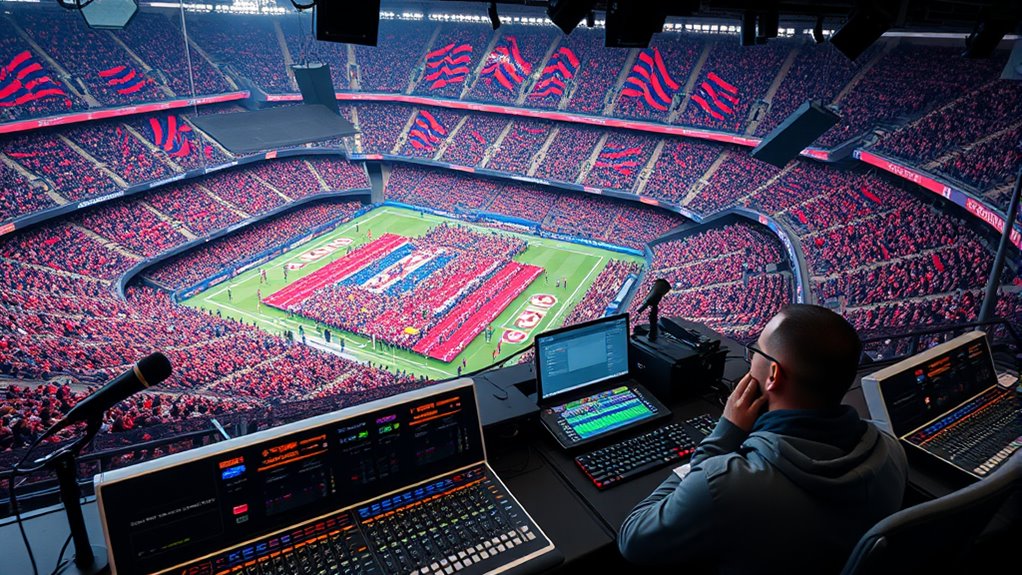
Once you’ve set up your microphone equipment, the next step is ensuring that each microphone level is properly balanced. Proper microphone placement is essential; position mics close to the crowd or chant source without causing feedback or distortion. Adjust the sound level calibration carefully, starting with lower volumes and gradually increasing until the chant sounds clear and even. Use your mixer’s gain controls to fine-tune each channel, guaranteeing no single microphone overwhelms others. Regularly monitor levels during the event, making small adjustments as needed. Keep in mind that consistent microphone placement helps maintain balanced sound, preventing hot spots or weak spots in the chant. Additionally, understanding the benefits of airless paint sprayers can be analogous to optimizing sound system setup, as both require precise calibration for the best results. Precise calibration and thoughtful placement ensure a dynamic, immersive experience for everyone.
Managing Reverberation and Echo Effects

Managing reverberation and echo effects is essential for maintaining clear and intelligible sound during a stadium event. To achieve this, focus on three key strategies:
- Utilize reverberation control tools to minimize excessive echo, ensuring clarity.
- Implement echo suppression techniques with digital processors to reduce unwanted reflections.
- Adjust speaker placement and angles to prevent sound waves from bouncing excessively across surfaces.
- Selecting the appropriate home theatre projector can also enhance audio-visual synchronization and overall sound quality in large venues.
Strategies for Amplifying Crowd Chants

Effective amplification of crowd chants relies on strategic microphone placement and sound system tuning to guarantee energy and enthusiasm are clearly transmitted throughout the stadium. To boost crowd participation, position microphones near the stands where chants originate, ensuring clear capture of vocal energy. Use directional microphones to minimize background noise and focus on the crowd’s voices. Proper sound system tuning is essential to prevent distortion and ensure chants are projected evenly, making every voice heard. Incorporate delay speakers if necessary, so chants reach all sections simultaneously. This setup enhances chant amplification, encouraging more audience involvement and creating a unified, electrifying atmosphere. Additionally, understanding stadium sound system setup can help optimize microphone and speaker placement for maximum effect. When executed correctly, these strategies maximize crowd participation and sustain the stadium’s lively spirit throughout the game.
Addressing Challenges in Live Sound Reinforcement
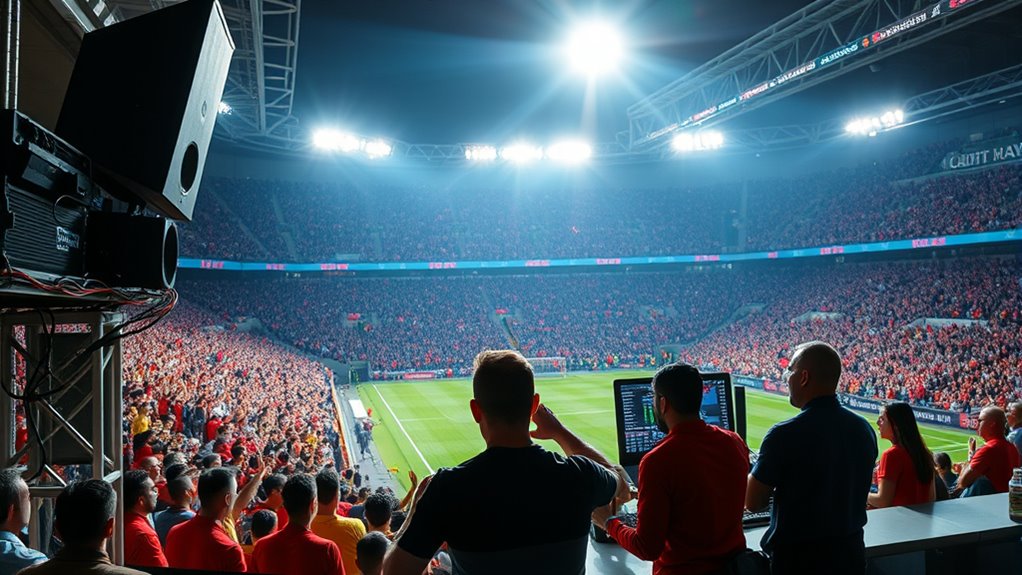
Live sound reinforcement in stadiums presents numerous challenges, from unpredictable acoustics to overwhelming crowd noise. To manage this, focus on three key areas:
- Speaker Placement: Position speakers strategically to minimize feedback and ensure even sound distribution across the stands.
- Crowd Noise Management: Use directional speakers and noise-canceling techniques to reduce the impact of crowd noise on audio clarity.
- Sound Check and Monitoring: Conduct thorough sound checks before events, adjusting speaker angles and levels to optimize intelligibility amid noise.
- Incorporating techniques from remote hackathons can also inspire innovative solutions for managing complex live sound environments.
Using Digital Processors for Clearer Audio

Digital processors have revolutionized stadium sound systems by allowing you to fine-tune audio signals with unmatched precision. With these tools, you can apply digital effects that enhance clarity, making chants and announcements stand out clearly. Sound compression helps you control volume levels, preventing harsh peaks and ensuring consistent audio quality throughout the crowd. By dynamically adjusting gain, compression reduces background noise and amplifies important sounds, making every cheer and call intelligible. You can also eliminate feedback issues and unwanted echoes more effectively than ever before. These processors give you the flexibility to customize sound profiles for different sections of the stadium, resulting in a more immersive experience. Additionally, sound quality can be improved through advanced digital filtering techniques, ensuring even the most energetic environments maintain clarity. Overall, digital processing ensures your audio remains clear, balanced, and impactful, even in the most energetic environments.
Ensuring Synchronization of Sound and Visuals
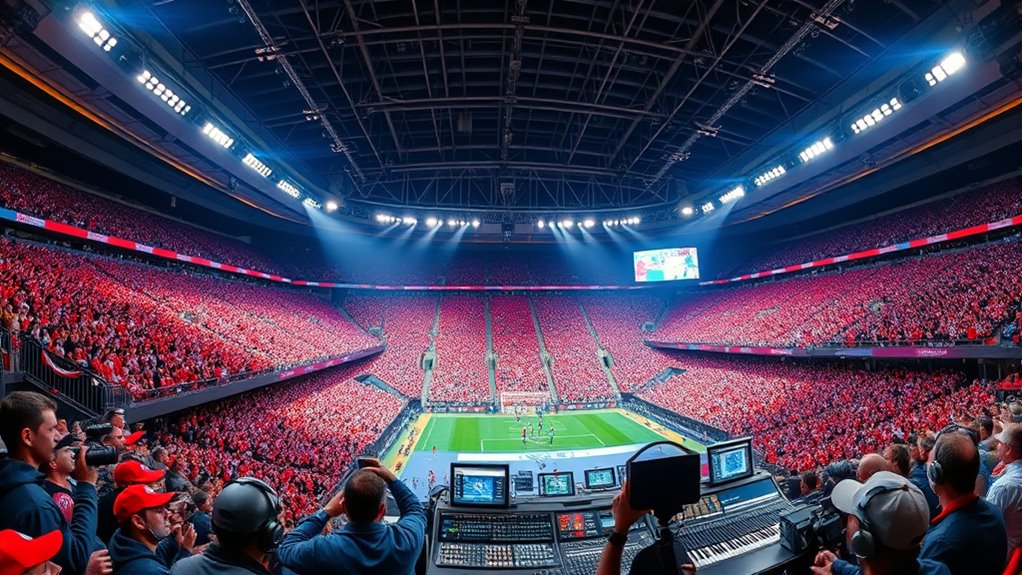
You need to keep sound and visuals perfectly aligned to deliver a seamless experience. Using timing precision techniques and visual-audio alignment strategies helps you achieve this. Real-time monitoring systems allow you to detect and correct synchronization issues instantly. Implementing world clock tools can assist in coordinating international events and ensuring consistent timing across different locations.
Timing Precision Techniques
Achieving perfect synchronization between sound and visuals at a stadium requires meticulous timing precision techniques. To enhance spectator engagement, you need precise audio calibration and real-time monitoring. Start with:
- Use precise timing software to align audio cues with visual signals, reducing lag.
- Regularly calibrate audio equipment before events to ensure consistent sound delivery.
- Employ synchronized delay systems that adjust sound output based on stadium acoustics and crowd density.
- Incorporate automation technologies to dynamically adapt audio timing in response to environmental changes during events.
These steps help maintain tight coordination, ensuring chants and visual effects hit simultaneously. Proper timing fosters a seamless experience, keeping spectators fully engaged. Accurate calibration and synchronization prevent delays that could disrupt the energy, making the environment more immersive and lively. Mastering these techniques is essential for delivering a unified, electrifying atmosphere during stadium events.
Visual-Audio Alignment Strategies
Effective visual-audio alignment guarantees that sound effects, commentary, and visual cues appear synchronized, creating a cohesive experience for spectators. Achieving this visual harmony enhances audience engagement by ensuring chants, signs, and on-screen visuals complement each other seamlessly. To maintain synchronization, use precise timing protocols, calibrate audio-visual equipment regularly, and implement consistent cues during events. Consider this table for clarity:
| Strategy | Purpose | Benefit |
|---|---|---|
| Signal Synchronization | Match audio with visual cues | Reduces lag, improves flow |
| Real-Time Adjustment | Correct delays during events | Keeps visuals and sound aligned |
| Pre-Event Testing | Ensure setup accuracy before the event | Prevents disruptions |
| Consistent Cues | Use standardized triggers | Maintains visual harmony |
Additionally, employing professional sound engineers can help optimize overall audio quality and synchronization. This approach guarantees an engaging experience, keeping fans invested and immersed in the event.
Real-Time Monitoring Systems
Real-time monitoring systems play a crucial role in maintaining precise synchronization between sound and visuals during live stadium events. These systems help you track crowd noise levels and ensure audio clarity. By continuously analyzing microphone placement, you can adapt quickly to shifting noise sources. To maximize the system, focus on:
- Monitoring crowd noise to detect peaks and troughs that may affect sound timing.
- Adjusting microphone placement in real-time for ideal capture and minimal delay.
- Using feedback from the system to fine-tune audio delays, ensuring chants stay synchronized with visuals.
- Understanding the importance of contrast ratio in projectors, which influences how well dark scenes and detailed visuals are perceived, ultimately enhancing the overall viewing experience.
This approach minimizes lag and enhances the fan experience. Keeping real-time data at your fingertips allows you to react swiftly, maintaining seamless coordination between sound and video during high-energy moments.
The Impact of Acoustic Design on Chant Clarity
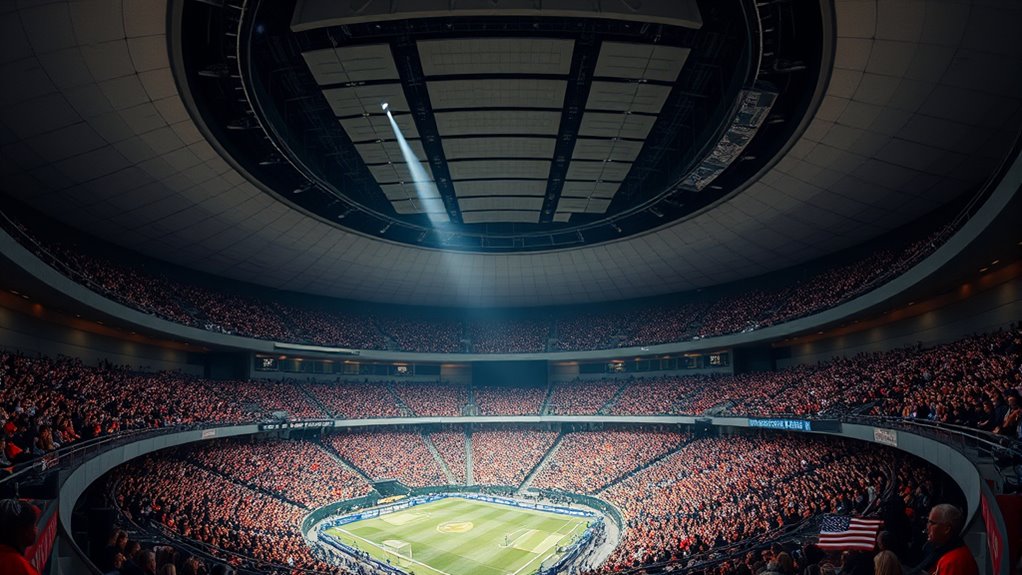
The acoustic design of a stadium plays a crucial role in ensuring that chants remain clear and impactful for everyone in the stands. When the acoustics are optimized, you’ll notice stronger audience engagement, as fans can easily hear and join in chants. Acoustic zoning is essential here; it divides the stadium into sections with tailored sound treatment, minimizing echo and sound muddling. This sound-focused environment helps prevent sound loss and unwanted reverberations, creating a focused setting that allows chants to project clearly across different zones. Proper design reduces sound loss and prevents unwanted reverberations, so your team’s cheers stay vibrant without distortion. By paying attention to the stadium’s acoustic layout, you enhance the collective experience, making chants more powerful and memorable for everyone present. Good acoustic design directly elevates the atmosphere and unity of the crowd.
Innovations in Stadium Sound Technology

Innovations in stadium sound technology are transforming how you experience live events. Advanced acoustic systems now deliver clearer sound across large venues, ensuring every cheer and chant is heard. With real-time sound modulation, engineers can adapt audio to changing crowd dynamics instantly. Additionally, understanding crowd behavior and regional venue statistics can help optimize sound distribution for maximum impact.
Advanced Acoustic Systems
Advancements in acoustic technology have transformed how stadiums deliver clear, immersive sound experiences. You now benefit from surround sound systems that create a dynamic audio environment, making chants feel like they’re happening right next to you. Additionally, audio zoning allows engineers to direct sound precisely where needed, reducing noise spillover and enhancing clarity. To optimize these systems, consider these key innovations: 1. Implementing surround sound setups that envelop the crowd in clear, balanced audio. 2. Using audio zoning to tailor sound delivery to specific sections, ensuring uniformity. 3. Incorporating intelligent speakers that adapt to crowd size and ambient noise levels automatically. Enhanced sound clarity ensures that every chant is heard and understood, further elevating the stadium atmosphere. These advancements make chants more vibrant and intelligible, heightening your stadium experience and fostering a stronger sense of unity among fans.
Real-Time Sound Modulation
As crowd noise and event dynamics change rapidly, stadium sound systems now utilize real-time sound modulation to adapt instantly. This technology monitors crowd noise levels continuously, adjusting sound levels accordingly to maintain clarity without overwhelming the audience. When the crowd erupts with chants or cheers, the system subtly amplifies or dampens sound to ensure everyone hears the intended messages and music without distortion. By responding instantly to fluctuations in crowd noise, real-time sound modulation enhances the overall stadium experience, making it more immersive. It prevents sound from becoming too loud or too quiet, helping organizers deliver clear announcements and balanced acoustics. This innovation keeps the atmosphere lively and synchronized with the energy of the fans, ensuring an ideal auditory environment at all times. Regularly assessing and adjusting sound parameters helps optimize the system’s performance and meet the evolving needs of the crowd.
Frequently Asked Questions
How Do Sound Engineers Prevent Crowd Noise From Overpowering Announcers?
To prevent crowd noise from overpowering announcers, you focus on crowd noise mitigation and microphone balancing. You strategically position microphones to capture clear announcer voices while minimizing background sounds. Using directional mics and adjusting gain levels helps balance the audio. You also implement noise gates or filters to reduce ambient noise. This way, your announcers stay clear and prominent, ensuring fans hear the game commentary without crowd noise interference.
What Practices Ensure Consistent Sound Quality Across Large Stadiums?
To guarantee consistent sound quality across large stadiums, you should focus on acoustic calibration and strategic speaker placement. Regularly calibrate the acoustics to account for stadium size and shape, minimizing echoes and dead zones. Position speakers thoughtfully to evenly distribute sound, avoiding areas where sound might distort or weaken. With proper calibration and placement, you’ll provide clear, balanced audio experience for everyone, regardless of their seating location.
How Are Wireless Microphones Managed During High-Energy Chants?
During high-energy chants, you manage wireless microphones through careful wireless frequency coordination to prevent interference. You guarantee proper microphone placement to minimize feedback and maximize clarity. By monitoring frequencies in real-time, you can quickly switch channels if interference occurs. This proactive approach keeps sound consistent, allowing the crowd’s chants to come through clearly without disruptions, creating an engaging experience for everyone in the stadium.
What Methods Are Used to Prevent Feedback During Live Performances?
To prevent feedback during live performances, you should implement feedback suppression technology and acoustic treatment. Use digital processors to identify and reduce feedback frequencies quickly. Position microphones carefully, keeping them away from speakers. Apply acoustic panels and diffusers to minimize sound reflections that can cause feedback. Regularly monitor sound levels and adjust microphone placements as needed. These methods guarantee clear sound without unwanted squeals, keeping your performance seamless.
How Do Engineers Adapt Sound for Different Weather Conditions?
Imagine your sound system as a sailboat steering changing seas. Weather adaptation involves adjusting your acoustic calibration to counter wind and rain’s effects, ensuring clear sound. You tweak equalization, reposition speakers, and sometimes add weather-resistant gear. By constantly monitoring and adapting, you keep your audio steady, so your performance remains powerful and clear, no matter if the weather turns stormy or calm, guiding your sound smoothly through any conditions.
Conclusion
By mastering sound management, balancing levels, and embracing new technologies, you create an electrifying atmosphere. You amplify chants, clarify voices, and enhance the crowd’s experience. You manage reverberation, synchronize visuals, and adapt to acoustic challenges. You guarantee every cheer resonates clearly, every chant sounds powerful, and every game becomes unforgettable. With skill and innovation, you turn stadium sound engineering into an art that elevates the passion and energy of sports fans everywhere.
